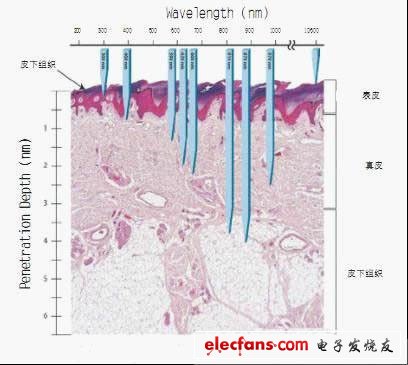1. Optical parameters that affect LED biological effects
The biological effects of LEDs depend on different optical parameters, including different wavelengths, flux, power density, irradiation time, continuous wave or pulse wave, and the number of clinical treatments and treatment intervals. Different wavelengths can reach different locations of skin tissue (see Figure 1). Generally speaking, the longer the wavelength, the stronger the penetration ability. The distance of the skin tissue penetrated at 400nm does not exceed 1mm, the penetration distance of 514nm is about 0.5mm ~ 2mm, and the penetration distance of 630nm is about 1mm ~ 6mm. At the same time, light of different wavelengths can be absorbed by different color bases in the tissue. In clinical practice, red light (630nm ~ 700nm) is often used to treat deep skin tissue structures, such as sebaceous glands; blue light (400nm ~ 470nm) is used to treat skin lesions located on the epidermis in photodynamic therapy (PDT) ; If you want to reach the dermal layer of the skin, you need a longer wavelength, such as the wavelength of 660nm can reach the reticular layer of the dermis to play a role in the skin fibroblasts in the dermis, and this is also the principle of LED light source for photorejuvenation one. Table 1 lists the LED optical parameters commonly used in clinic.


2. Application of LED in dermatology
1. PhotorejuvenaTIon
Photon skin rejuvenation technology is defined as the use of continuous intense pulsed light to perform skin rejuvenation in a non-exfoliative manner at a low energy density. In just a few years since its introduction in 2000, photon skin rejuvenation technology has rapidly spread throughout the country and has been widely used in major cities. It has become one of the main means of improving skin photoaging. This technology can significantly improve skin wrinkles and texture Roughness, irregular pigmentation and enlarged pores have been recognized by many technical professionals and beauty appealers. The characteristic histological changes of skin photoaging are the degeneration of elastic fibers in the dermal matrix and the obstacles to the maturation of collagen fibers, which leads to skin relaxation and wrinkles.
Oval Series Sensor Automatic Dustbin
Auto Trash Can,Oval Series Sensor Automatic Dustbi,Oval Series Sensor Dustbin,Oval Series Sensor Office Dustbin
NINGBO ZIXING ELECTRONIC CO.,LTD. , https://www.zixingautobin.com
